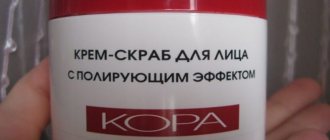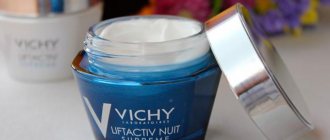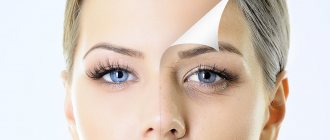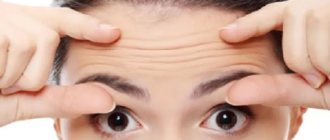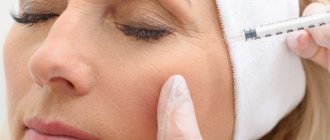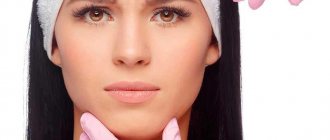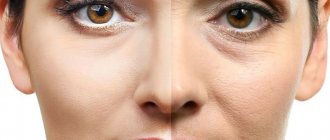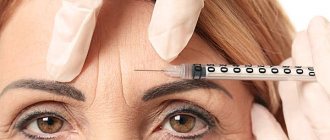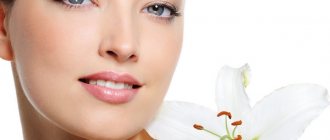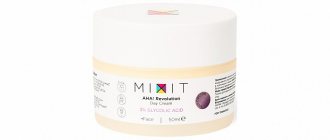Services Doctors Results Reviews
Expert tested
Sharubina Karina Petrovna Trichologist, dermatovenerologist, cosmetologist
Publication date: November 16, 2022
Review date: November 16, 2022
Expression wrinkles are the first signs of skin aging. They are the precursors of static wrinkles. They arise as a result of the activity of the facial muscles during the expression of emotions. A person’s facial muscles contract about 15 (!) thousand times a day.
From such intensive work, creases and grooves begin to form on the skin, which at a young age disappear without a trace at rest. After all, the skin in youth is dense and elastic. The collagen fibers in it contract perfectly and return to their original position. However, over the years, regular muscle contraction leaves traces of deep folds and furrows on the face.
With age, the connections between the dermal and epidermal layers are disrupted and elastosis develops (wear and degeneration of elastic fibers). Also, with age, the tone of facial muscles is disrupted. As a result, in some groups of facial wrinkles the tone decreases, while in others, spastic contractions predominate.
Table of contents
- Ethology and pathogenesis
- Clinical manifestations
- Principles of treatment
Expression wrinkles (wrinkles on the face, mimetic wrinkles , expression lines) are visible bends in the relief of the skin of the face that appear during contraction of the superficial muscular-aponeurotic system. Expression wrinkles can be superficial (fine lines) or deep (folds). An important pathogenetic condition for their formation is the presence of dermal elastosis.
In our company you can purchase the following equipment for the correction of facial wrinkles:
- M22 (Lumenis)
- AcuPulse (Lumenis)
- UltraPulse (Lumenis)
- Fraxel (Solta Medical)
How to get rid of facial wrinkles? Without exaggeration, we can say that facial wrinkles appear in all people over time, but more often they become visible after 40 years. Smoking aggravates the situation, and women are more susceptible to these changes compared to men.
The time of appearance of facial wrinkles largely depends on the race and phototype of a person’s skin, his genetics, nutrition, physical (and facial) activity, place of residence and other factors. For example, Europeans (phototypes I–III) are more prone to wrinkles on their faces. At the same time, Asians and African Americans can maintain smooth skin for a long time. This is partly due to the protective effect of skin melanin against sunlight and subsequent photoaging.
We restore youth to the skin
Regular skin care should become an unchanging ritual for every woman.
Unfortunately, among the female part of the population there is an opinion that the need to use anti-wrinkle cream arises after 30 years. Fundamentally wrong!
Delicate women's skin is subject to negative influences even at 20 years old. But at a young age it recovers faster, so it is difficult to notice emerging wrinkles.
Without paying due attention to her beauty, by the age of 30 a woman risks developing deep wrinkles that even the best anti-wrinkle cream cannot cope with.
Unfortunately, anti-wrinkle cosmetics, no matter how ultra-modern they are, are not able to “freeze” female beauty in its original form.
It just slows down the withering process. But wrinkle smoothing cream, in any case, will become an indispensable tool for prolonging youth.
Ethology and pathogenesis of facial wrinkles
A distinctive feature of the face is the presence of the superficial muscular aponeurotic system (Superficial Musculoaponeurotyc System, SMAS ). It forms a three-dimensional network with strands of connective tissue that connect to the dermis. These bands are made up of collagen and elastin fibers that are attached to the skin (but not to the bones) in many places. By contracting, the muscles pull the skin along with them, as a result of which the facial expression changes - the eyebrows frown, the forehead wrinkles, the lips stretch into a smile, etc.
This anatomy provides a variety of human facial expressions, but at the same time creates the prerequisites for the formation of wrinkles and folds ( Fig. 1 ). Firstly, when muscles contract, they constantly stretch the skin, which negatively affects its elasticity and gradually leads to sagging. Secondly, due to the fact that SMAS is not connected to the bones of the face, when the content of collagen and elastin in its connective tissue cords changes, the skin becomes flabby over time and begins to partially sag. This creates the preconditions for the visualization of facial wrinkles, which become more noticeable.
the epidermis play a certain role in the appearance of facial wrinkles . Here, there is a slowdown in cellular renewal, a decrease in the activity of natural moisturizing factor and an increase in transepidermal water loss, which overall makes the skin drier and more fragile.
In the dermis, the amount of collagen decreases (by about 2% per year) and the activity of matrix metalloproteinases (MMPs) increases, as a result of which collagen fibers are damaged. Elastin degrades more slowly, so aging skin often exhibits elastosis, which overall increases the visibility of facial wrinkles.
Smoking greatly contributes to the appearance of visible wrinkles . Tobacco smoke increases the activity of MMPs, which destroy dermal collagen, and at the same time triggers the synthesis of tropoelastin. As a result, against the background of skin elastosis, the visibility of facial wrinkles worsens.
Finally, last on the list, but not least important factor is sunlight . Ultraviolet B (UVB) induces the production of MMPs, which promote collagen degradation and extracellular matrix remodeling. In this case, elastin fibers try to compensate for the destruction of collagen through hypertrophy.
Expression wrinkles increase under the influence of stress, diseases of internal organs, alcohol abuse, reduced body weight, environmental pollution, etc.
Rice. 1. Changes in skin texture: A - fine mesh, B - facial wrinkles, C - deep furrows (Lemperle G., Holmes RE, Cohen SR, Lemperle SM A classification of facial wrinkles. Plast Reconstr Surg 2001; 108: 1751–1752)
| A | IN | WITH |
Clinical manifestations
Wrinkles can form at any age, but more often after 40 years. At first they appear in the form of thin lines, gradually deepening to large furrows. Expression wrinkles (dynamic) usually become noticeable between the ages of 40 and 50, while static wrinkles begin to form after the age of 50.
Classification of wrinkles (functional classes according to Panova):
- Class 0 - no wrinkles.
- Class 1 - superficial facial or static wrinkles that disappear when the face relaxes.
- Class 2 - medium-deep facial or static wrinkles, the presence of small superficial wrinkles, changes in skin texture, pigmentation disorders.
- Class 3 - deep facial and static wrinkles, the presence of pronounced changes in skin texture, pigmentation disorders, and the possible presence of excess skin.
The very first facial wrinkles that bother some women even after 30 years are the forehead and eyebrow wrinkles. They become especially noticeable when frowning. Subsequently, wrinkles appear in the eye area (“crow’s feet” or “crow’s feet”), the visibility of nasolabial folds (“marionette lines” or “marionette lines”) increases, static wrinkles appear on the cheeks, neck and other areas ( Fig. 2 ).
Rice. 2. Expression wrinkles on aging skin
Principles of treatment and correction of facial wrinkles
How to get rid of facial wrinkles? As a preventative method of combating facial wrinkles, it is recommended to limit the time spent in the open sun . For clothing, you should choose floor-length skirts or pants, blouses and shirts with long sleeves, and wide-brimmed hats. You should regularly apply sunscreen cosmetics with SPF 30+ to your face. If the patient smokes, it is necessary to give him recommendations on how to get rid of this habit.
To reduce the severity of facial wrinkles, facial massage . It prevents the development of sagging skin, improves local blood circulation and increases the tone of facial muscles, which helps to visually reduce facial wrinkles. The main benefit of this approach is prevention, while on skin with significant age-related and other changes, the massage effect will be relatively weak.
Muscle relaxant peptides can be used to correct unwanted facial wrinkles . In advertising, they are often called “peptides with a Botox effect,” although not all of them have a mechanism of action similar to botulinum toxins. It is important that muscle relaxants reduce the severity of only facial wrinkles - they do not affect static wrinkles that appear as a result of age-related skin changes.
The most famous of the muscle relaxants is the peptide argireline . It competes with one of the proteins that is involved in creating the complex necessary for the release of acetylcholine into the synaptic cleft - as a result, the complex is inactivated and the muscle stops contracting. The negative point is that for the full effect to develop, it is necessary to use the product for at least 30–35 days.
Since elastosis plays a certain role in the formation of expression lines, its treatment methods are also suitable in this case. Topical retinoids, antioxidants, and chemical peels will be helpful.
The most popular procedure for correcting facial wrinkles is the injection of botulinum toxins into the “problem” area. Botulinum toxins block the release of acetylcholine into the synaptic cleft of the neuromuscular junction, which promotes relaxation of the target area of the face. When selecting patients for the procedure, choosing dosages and correction regimens, the individual characteristics of the patient should be taken into account, since they directly affect both the aesthetic result and the safety of the correction. The effect of this procedure is short-lived, and after a few months the botulinum toxin injection should be repeated.
Hardware techniques do not affect the causes of expression wrinkles (in particular, muscle tone), but can reduce their severity by launching cellular renewal processes, increasing the activity of growth factors, and the synthesis of new collagen and skin microvessels. All this improves the condition of the face, removing facial wrinkles, making them less noticeable.
Ablative fractional lasers are suitable for solving the problem - typical representatives are the Ultrapulse and Acupulse devices. They intensively impact the surface of the skin with many micro-rays, evaporating its top layer to a certain depth. Intact areas remain between treatment zones, which allows the skin to use their “building materials” to activate powerful regenerative processes and rapid healing. Since the impact is quite strong, the procedure is followed by a period of rehabilitation for the patient. Moreover, the effect appears in just one session.
Non-ablative fractional lasers act more gently on the skin, so the effect appears after several sessions. But after each procedure, no rehabilitation is required, and the patient can immediately engage in normal daily activities. Typical representatives of non-ablative fractional lasers are M22 ResurFX and Fraxel.
Since laser techniques do not block facial activity, which is one of the most important reasons for the appearance of facial wrinkles, hardware treatment is recommended to be combined with courses of botulinum toxin. In this case, the achieved effect will be maximally pronounced and lasting.
For youth - to the pharmacy
The fair half of humanity does not always trust cosmetic companies to take care of their skin health. The concerns are quite understandable: cosmetics often contain preservatives, synthetic fragrances, and silicones.
In this case, ladies believe that the best anti-wrinkle cream can only be purchased... at a pharmacy.
Popular ointments are:
- Relief;
- Solcoseryl;
- Curiosin.
If you decide to take care of your skin using pharmaceutical preparations, first do an allergy test. Having eliminated the risk of an allergic reaction, you can begin to take action.
And remember the answer to the question whether anti-wrinkle cream helps will not come right away.
Remember that alternative skin care cannot be used all the time. The procedures are recommended to be carried out in a short course, lasting 2 weeks.
